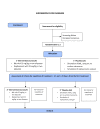Efficacy and safety of exogenous surfactant therapy in patients under 12 months of age invasively ventilated for severe bronchiolitis (SURFABRON): protocol for a multicentre, randomised, double-blind, controlled, non-profit trial
- PMID: 33077567
- PMCID: PMC7574934
- DOI: 10.1136/bmjopen-2020-038780
Efficacy and safety of exogenous surfactant therapy in patients under 12 months of age invasively ventilated for severe bronchiolitis (SURFABRON): protocol for a multicentre, randomised, double-blind, controlled, non-profit trial
Abstract
Introduction: Some evidence indicates that exogenous surfactant therapy may be effective in infants with acute viral bronchiolitis, even though more confirmatory data are needed. To date, no large multicentre trials have evaluated the effectiveness and safety of exogenous surfactant in severe cases of bronchiolitis requiring invasive mechanical ventilation (IMV).
Methods and analysis: This is a multicentre randomised, placebo-controlled, double-blind study, performed in 19 Italian paediatric intensive care units (PICUs). Eligible participants are infants under the age of 12 months hospitalised in a PICU, suffering from severe acute hypoxaemic bronchiolitis, requiring IMV. We adopted a more restrictive definition of bronchiolitis, including only infants below 12 months of age, to maintain the population as much homogeneous as possible. The primary outcome is to evaluate whether exogenous surfactant therapy (Curosurf, Chiesi Pharmaceuticals, Italy) is effective compared with placebo (air) in reducing the duration of IMV in the first 14 days of hospitalisation, in infants suffering from acute hypoxaemic viral bronchiolitis. Secondary outcomes are duration of non-invasive mechanical ventilation in the post-extubation phase, number of cases requiring new intubation after previous extubation within 14 days from randomisation, PICU and hospital length of stay (LOS), duration of oxygen dependency, effects on oxygenation and ventilatory parameters during invasive mechanical respiratory support, need for repeating treatment within 24 hours of first treatment, use of other interventions (eg, high-frequency oscillatory ventilation, nitric oxide, extracorporeal membrane oxygenation), mortality within the first 14 days of PICU stay and before hospital discharge, side effects and serious adverse events.
Ethics and dissemination: The trial design and protocol have received approval by the Italian National Agency for Drugs (AIFA) and by the Regional Ethical Committee of Verona University Hospital (1494CESC). Findings will be disseminated through publication in peer-reviewed journals, conference/meeting presentations and media.
Trial registration number: Clinicaltrials.gov, issue date 22 May 2019. NCT03959384.
Keywords: clinical trials; paediatric infectious disease & immunisation; paediatric intensive & critical care; paediatric thoracic medicine.
© Author(s) (or their employer(s)) 2020. Re-use permitted under CC BY-NC. No commercial re-use. See rights and permissions. Published by BMJ.
Conflict of interest statement
Competing interests: PB has received speaker fees from Chiesi Group. AW has received speaker fee from Takeda. FC and PS received travel funding by Chiesi. All other authors (SSC, EG, IR, AM, CM, FS, RS, GG, MB, MF, AP, VS, LD, GZM, EC, SSC, AB, FT, EB, DB, GI) report no competing interests.
Figures
References
-
- Mazur NI, Martinón-Torres F, Baraldi E, et al. . Respiratory syncytial virus network (ReSViNET). lower respiratory tract infection caused by respiratory syncytial virus: current management and new therapeutics. Lancet Respir Med 2015;3:888–900. - PubMed
Publication types
MeSH terms
Substances
Associated data
LinkOut - more resources
Full Text Sources
Medical

